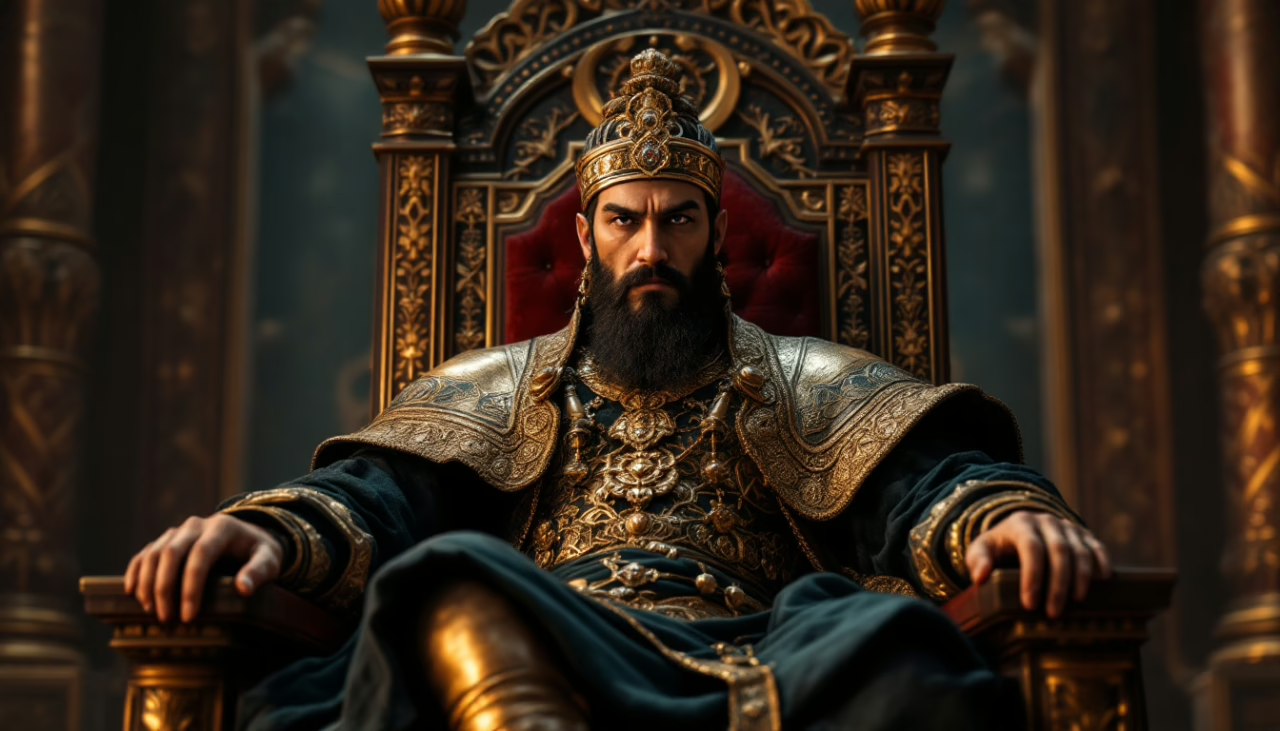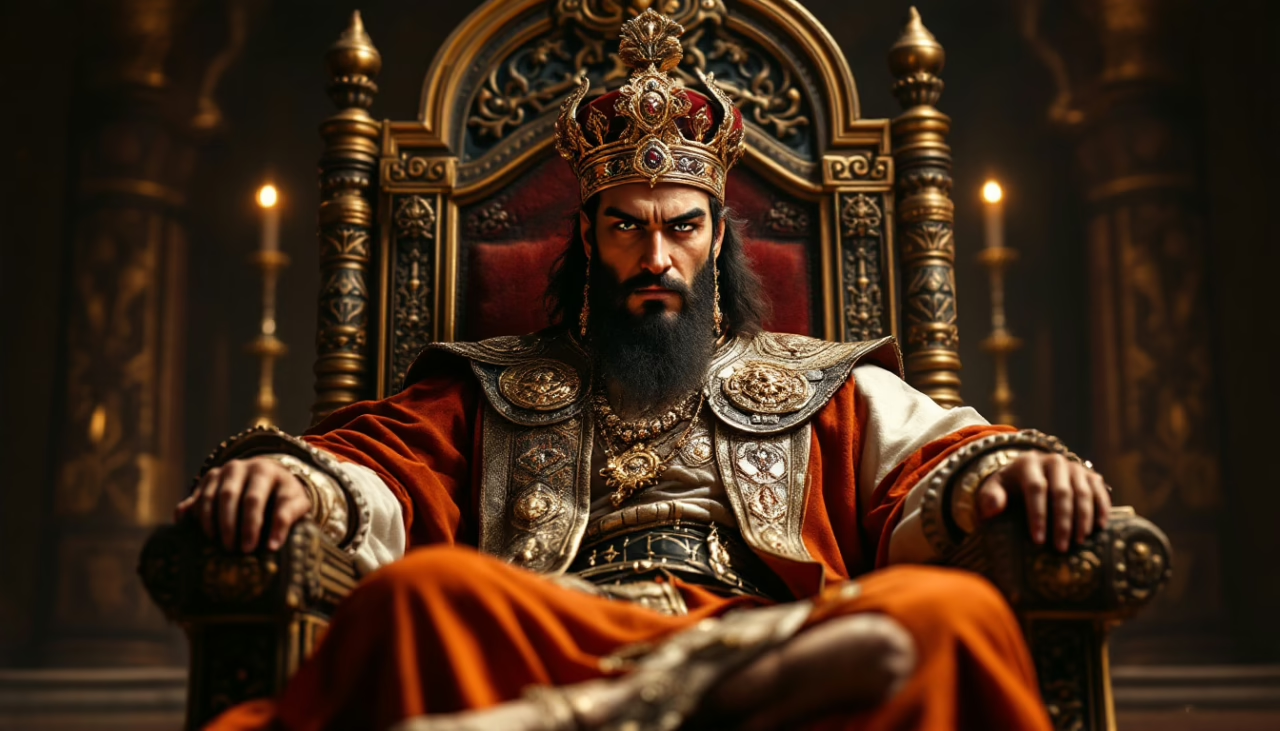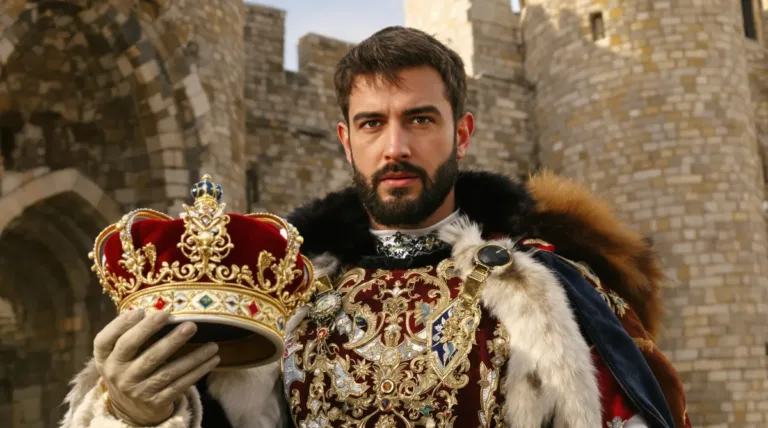Tamerlane: Legendary Conqueror or Brutal Monster?

Tamerlane stands as history’s great paradox: architectural patron and mass murderer, military innovator and destroyer of civilizations.
His campaigns across Asia left pyramids of skulls in Delhi and Damascus, yet his patronage transformed Samarkand into a Renaissance of Islamic art and science.
Modern scholars grapple with these contradictions, weighing his administrative genius against his unprecedented brutality.
The question remains whether such extremes can coexist within one historical figure, or if our understanding of this enigmatic conqueror must ultimately choose between legend and monster.
Principal Conclusions
Hide- Tamerlane created a vast empire through military brilliance but employed unprecedented brutality, killing up to 17 million people.
- He transformed Samarkand into a cultural and architectural marvel while systematically destroying other ancient cities like Baghdad.
- Historic perspectives vary dramatically, with Central Asians revering him as a hero while victims' descendants remember him as barbaric.
- His campaigns featured psychological warfare and tactical innovation alongside horrific atrocities like skull pyramids in Delhi.
- Tamerlane's paradoxical legacy balances cultural patronage and intellectual development against some of history's most devastating massacres.
The Rise of Tamerlane: From Humble Beginnings

Despite his eventual ascension as Central Asia’s most formidable ruler, Tamerlane emerged from surprisingly modest origins in Transoxiana, born to a minor Turkic tribal family in 1336 CE.
His transformation from an unremarkable youth to a battle-hardened warrior occurred through years of military service, personal resilience, and calculated political alliances among the fractious Chagatai Khanate.
Through strategic marriages, diplomatic maneuvering, and decisive military campaigns against rival factions, Tamerlane systematically consolidated power throughout the 1360s, establishing Samarkand as the magnificent capital of what would become one of history’s most extensive empires.
Early Life: The Making of a Warrior
Born in 1336 near Samarkand in modern-day Uzbekistan, Tamerlane emerged from modest Turkic-Mongol origins during a period of profound regional instability.
Historical chronicles suggest his early years were marked by both intellectual development—studying Islamic theology and military strategy—and physical hardship, which forged his legendary resilience and tactical acumen.
His ascent from obscurity began with small-scale raids and clever alliances, where he demonstrated exceptional leadership abilities that attracted followers impressed by his combination of martial prowess and strategic foresight.
Childhood and Upbringing in Central Asia
Amid the windswept steppes of Central Asia in 1336, Timur—later known as Tamerlane—entered a world characterized by tribal conflict and Mongol influence.
Born into the Barlas tribe, his formative experiences included horsemanship, archery, and tactical observation.
Tamerlane’s family, though not impoverished, navigated childhood challenges typical of nomadic societies, while Central Asian culture’s emphasis on resilience shaped his emerging identity.
Early Battles and Leadership Qualities
Tamerlane first established his military prowess through a series of skirmishes along the Syr Darya region around 1360, transforming from an obscure tribal warrior into a formidable commander whose tactical brilliance would eventually reshape Central Asia.
His early victories demonstrated innovative battle tactics, including feigned retreats and strategic planning that exploited terrain advantages—leadership styles that balanced calculated brutality with pragmatic alliances, establishing his distinctive military signature.
Ascending to Power: Establishing an Empire
Tamerlane’s ascension to power began with a series of strategic conquests, characterized by diplomatic alliances when advantageous and swift military brutality when necessary.
His early victories over neighboring Chagatai Khanate territories established a pattern of tactical brilliance that would define his expansion, simultaneously crushing rivals while incorporating their strengths into his growing military apparatus.
Initial Conquests and Strategies
The early military campaigns of the Chagatai warlord reveal a consummate strategist whose tactical innovations would shape conquest patterns across Asia for generations to follow.
Tamerlane’s tactics emphasized mobility and psychological warfare, forging strategic alliances with religious authorities while dismantling rival powers.
His battlefield innovations—particularly in siege warfare and cavalry deployments—reflected deeper conquest motivations beyond mere territorial expansion.
Key Victories That Expanded His Influence
Smashing through the formidable defenses of Damascus in 1400, a conquest that solidified his dominance across Central Asia, marked just one of many decisive military victories that transformed a regional warlord into an empire-builder of unprecedented scope.
His key military strategies—employing psychological warfare alongside tactical brilliance—facilitated territorial expansion methods that yielded pivotal battle outcomes in Delhi, Baghdad, and Ankara, where influential alliances formed through intimidation rather than diplomacy.
The Scale of His Empire: Tamerlane’s Vast Dominion
Tamerlane’s empire, stretching from the Caspian Sea to northern India and from the Euphrates to the Ganges, represented one of history’s most rapidly assembled dominions.
At its heart stood Samarkand, a resplendent metropolis transformed through plundered wealth and captive artisans into what contemporaries described as “the mirror of the world.”
His territorial control, achieved through brutal conquest rather than administrative innovation, created a vast but ephemeral power structure that would collapse almost immediately following his death in 1405.
Extent of Tamerlane’s Territories
Tamerlane’s empire, stretching from the fertile plains of Persia to the riches of northern India, constituted one of history’s most rapidly acquired territorial dominions.
His administrative innovations, including sophisticated tax systems and strategic placement of loyal governors, guaranteed control over disparate regions despite their cultural and geographic diversity.
Through calculated military campaigns and shrewd political maneuvering, Tamerlane established a governance framework that, while brutal in implementation, demonstrated remarkable efficiency in managing vast territories across Central Asia, the Middle East, and portions of South Asia.
From Persia to India: Key Regions Conquered
While the grand sweep of fourteenth-century conquest has produced many remarkable military campaigns, few rival the territorial expansion orchestrated by Timur between 1370 and 1405.
His systematic annexation of Persian territories demonstrated tactical brilliance, while his Indian campaigns revealed brutal efficiency.
Regional resistance often crumbled before his conquest strategies, though cultural exchanges inevitably flourished in conquered lands despite devastating bloodshed.
Administrative Innovations Across the Empire
Spanning vast territories from Damascus to Delhi, the empire established under Timur’s rule represented one of history’s most extensive contiguous domains, requiring sophisticated administrative systems to maintain control across diverse regions.
Timur’s governance innovations included:
- Decentralized administrative reforms balancing local autonomy with imperial oversight
- Hierarchical bureaucratic organization employing meritocratic civil service appointments
- Progressive tax systems accommodating regional economic disparities
- Codified governance structures adapting Persian administrative traditions
Samarkand: Jewel of Tamerlane’s Realm
Samarkand, transformed under Tamerlane’s ambitious vision, emerged as the magnificent centerpiece of his sprawling empire through architectural marvels that combined Persian, Central Asian, and Islamic traditions.
The city’s spectacular blue-domed mosques, madrasas, and mausoleums—including the renowned Bibi-Khanym Mosque and Gur-e-Amir complex—stood as physical manifestations of both imperial power and cultural sophistication.
Within this resplendent capital, Tamerlane cultivated a remarkable intellectual environment, attracting scholars, artisans, and poets from across the conquered territories, thereby establishing Samarkand as a flourishing nexus of cultural exchange that would influence Central Asian aesthetics for centuries.
Architectural Legacy of Tamerlane’s Capital
The architectural grandeur of Tamerlane’s capital stands as perhaps the most enduring proof of his imperial vision, transforming a modest Central Asian city into an unparalleled center of artistic and cultural achievement.
Timurid architecture exemplified Tamerlane’s geopolitical dominance through cultural synthesis and artistic patronage:
- Monumental scale of Samarkand’s Bibi-Khanum Mosque and Registan complex
- Innovative structural engineering techniques blending Persian and Central Asian traditions
- Strategic deployment of azure-blue tilework symbolizing celestial authority
- Mathematical precision in geometric patterns reflecting intellectual sophistication
Cultural Flourishing under His Rule
Beyond Tamerlane’s architectural achievements lay a profound cultural renaissance that transformed Samarkand into a nexus of intellectual and artistic innovation during the late 14th and early 15th centuries.
His patronage catalyzed unprecedented cultural exchange, drawing scholars who advanced astronomy and mathematics.
Libraries flourished alongside educational growth in madrasas, while artisans developed distinctive styles through unprecedented artistic innovation, merging Persian, Turkic, and Mongol influences into remarkable cultural synthesis.
Military Genius or Ruthless Tyrant?
Tamerlane’s military acumen manifested in sophisticated battlefield innovations, including psychological warfare and strategic deception, which established his reputation as one of history’s most formidable tacticians.
This tactical brilliance, however, coexisted with a calculated brutality exemplified by his orchestration of civilian massacres in Baghdad, Damascus, and Delhi, where pyramids of severed heads served as grim monuments to his conquests.
Contemporary Persian and Arabic chronicles document both his strategic genius and merciless methods, presenting historians with the paradox of a commander whose military achievements remain inseparable from the atrocities committed in their pursuit.
Tactics and Strategies: Mastery in Warfare
Tamerlane’s ascendancy to military dominance largely stemmed from his masterful application of innovative tactics that confounded his adversaries, including his distinctive use of mobile cavalry forces and strategic deception.
His approach to siege warfare demonstrated a calculated brutality, often constructing towers of skulls outside besieged cities—a psychological weapon designed to erode enemy morale before physical battles commenced.
These psychological tactics, combined with his willingness to exterminate entire populations that resisted, reveal the interwoven nature of Tamerlane’s military genius and his ruthless disregard for human suffering, challenging modern observers to reconcile his tactical brilliance with the devastating humanitarian consequences that followed in his wake.
Innovative Military Techniques
While historians debate the moral dimensions of his conquests, few dispute the revolutionary military innovations that propelled Timur’s armies to victory across Asia and beyond.
Tamerlane’s tactical innovations transformed medieval warfare:
- Strategic deception, including psychological warfare and feigned retreats
- Sophisticated siege techniques that neutralized fortified cities
- Adaptive military formations integrating cavalry mobility with infantry stability
- Masterful warfare logistics ensuring supply chains across vast terrains
Siege Warfare and Psychological Tactics
Terror served as both weapon and strategy in the sophisticated siege warfare methods employed by the Timurid forces.
Tamerlane’s psychological warfare manifested through calculated displays of brutality—towers of severed heads erected outside city walls—decimating enemy morale before physical combat commenced.
His propaganda strategies weaponized fear itself, circulating tales of Timurid ruthlessness that often prompted surrender from terrified opponents contemplating resistance against his siege tactics.
The Dark Side: Brutality and Massacres
The conquest of Delhi in 1398 and Baghdad in 1401 revealed Tamerlane’s most horrific proclivities, with contemporary accounts describing mountains of skulls—nearly 90,000 in Delhi alone—stacked as macabre monuments to his victories.
Defeated populations faced systematic brutalization: scholars and artisans were typically spared only to be deported to Samarkand, while ordinary citizens endured enslavement, torture, or execution depending on their perceived utility to the conqueror’s ambitions.
These calculated atrocities served both psychological warfare and pragmatic governance, simultaneously terrorizing potential resistors while eliminating demographic threats to Timurid control—a methodology that modern historians increasingly interpret not as mere barbarism but as the deliberate application of terror as statecraft.
Accounts of Destruction in Delhi and Baghdad
Blood flowed through the streets of Delhi in December 1398 when Tamerlane’s armies released unprecedented carnage upon the city, culminating in the massacre of nearly 100,000 prisoners before the main assault even began.
Historical accounts document Tamerlane’s ruthless siege strategies across conquered territories:
- Delhi’s destruction left structures decimated and survivors enslaved
- Baghdad’s population suffered systematic extermination in 1401
- Cultural landmarks and libraries deliberately razed
- Pyramids of severed heads erected as psychological warfare
Treatment of Defeated Populations
While conquering vast territories across Asia, Tamerlane implemented a systematic approach to subjugating defeated populations that oscillated between calculated mercy and unfathomable cruelty, depending entirely on their willingness to surrender without resistance.
His arsenal of control included mass executions, forced migrations, and cultural assimilation, alongside economic exploitation and psychological warfare—tactics deliberately designed to shatter resistance and transform conquered territories into submissive provinces.
Legacy of Bloodshed: Assessing the Human Cost
Historians continue to wrestle with the staggering death toll attributed to Tamerlane’s campaigns, with estimates suggesting his armies may have slaughtered as many as 17 million people—approximately 5% of the world’s population at that time.
This legacy of bloodshed extends beyond mere numbers into the domain of cultural heritage, where Tamerlane’s forces systematically razed ancient cities like Damascus and Baghdad while, paradoxically, preserving select artistic traditions in his capital of Samarkand.
The apparent contradiction between his role as both destroyer and patron presents modern scholars with a complex historical figure whose impact must be measured not only in pyramids of skulls, but also in the surviving architectural and intellectual treasures that flourished under his patronage.
Historical Estimates of Lives Lost
Chroniclers and modern historians have offered starkly divergent estimates of the casualties inflicted during Tamerlane’s conquests, with figures ranging from several hundred thousand to the oft-cited seventeen million deaths across Central Asia, the Middle East, and India.
These numbers, while difficult to verify with precision, suggest a scale of destruction that rivals or exceeds contemporaries like the Mongol conquests under Genghis Khan, though methodological challenges in demographic history complicate direct comparisons.
Primary sources, including accounts from Ibn Khaldun and Ruy González de Clavijo, describe with horrifying detail the systematic massacres at Damascus, Isfahan, and Delhi—where Tamerlane allegedly ordered towers constructed from the skulls of his victims—providing textual evidence that, despite possible exaggeration, points to extraordinary levels of deliberate violence as a tactical and psychological weapon.
Analysis of Historical Accounts
Precise quantification of Tamerlane’s human toll presents extraordinary challenges for modern scholars, as contemporary accounts—frequently colored by political agendas, cultural biases, and the inevitable distortions of oral transmission—offer wildly divergent estimates that defy easy reconciliation.
Historical narratives concerning Tamerlane’s conquests reveal:
- Persian sources emphasizing cultural devastation
- Russian chronicles stressing religious persecution
- Central Asian accounts highlighting imperial necessity
- European interpretations framing him within apocalyptic frameworks
Comparison to Other Historical Conquerors
While placing Tamerlane within a comparative framework of history’s most destructive conquerors reveals the staggering scale of his campaigns, scholarly estimates suggest his military operations resulted in approximately 17 million deaths—a figure that, when contextualized against both population demographics and other historical figures, illuminates the exceptional nature of his conquests.
Tamerlane’s contemporaries, unlike Genghis Khan, Alexander the Great, Julius Caesar, Attila the Hun, or even Napoleon Bonaparte, operated within different demographic realities, making comparative mortality assessments both challenging and revealing.
Cultural Destruction vs. Preservation
Tamerlane’s legacy embodies a jarring paradox: the same hands that razed magnificent cities—Damascus, Baghdad, and Delhi among them—also commissioned spectacular monuments and patronized Islamic scholarship in his capital of Samarkand.
While his armies stacked severed heads into grotesque pyramids outside conquered metropolises and systematically eliminated rival cultural repositories, Tamerlane simultaneously transported skilled artisans back to Central Asia, creating conditions for the remarkable Timurid Renaissance that would flourish under his descendants.
This tension between destroyer and builder underscores the complexity of historical judgment, revealing how cultural inheritance often emerges from the shadow of catastrophic loss.
Destruction of Cities and Cultural Centers
The destruction left in Tamerlane’s wake represents perhaps the most enduring and controversial aspect of his legacy, particularly his systematic obliteration of cultural centers across Asia and the Middle East.
His campaigns of cultural annihilation resulted in:
- Baghdad’s devastation in 1401, with centuries of architectural treasures reduced to rubble
- Delhi’s urban devastation, where thousands perished amid toppled monuments
- Isfahan’s methodical destruction, erasing Persian cultural achievements
- Damascus’s subjugation, with historical structures burned and scholarly works lost forever
Patronage of Arts, Science, and Architecture
Paradoxically, the same hands that orchestrated widespread cultural devastation also cultivated one of history’s most remarkable patronages of arts and intellectual pursuits.
Under Tamerlane’s rule, Samarkand transformed into a nexus of cultural exchanges and scientific advancements. His architectural innovations reshaped Central Asia’s skyline with magnificent structures reflecting diverse historical influences.
This dichotomy—destroyer yet creator—remains among history’s most perplexing contradictions.
Religious and Political Motivations
Tamerlane’s complex relationship with Islam informed his military campaigns, as he simultaneously portrayed himself as a defender of the faith while massacring Muslim populations who opposed his rule.
Historical records reveal his selective invocation of religious authority—consulting imams before battles yet disregarding Islamic prohibitions against excessive bloodshed when it suited his territorial ambitions.
Beyond religious justifications, his conquests served a clear political vision: to resurrect the fractured Mongol Empire under his sole authority, unifying disparate lands from Delhi to Damascus through a combination of diplomatic marriages, strategic alliances, and overwhelming military force.
Islam’s Role in Tamerlane’s Conquests
Tamerlane strategically invoked Islamic principles to sanctify his expansionist campaigns, portraying himself as a ghazi warrior defending and expanding Muslim territories against infidels.
His religious justifications, however, often masked practical political ambitions, evidenced by his brutal treatment of Muslim opponents in Damascus and Baghdad, whom he massacred despite their shared faith.
While nominally championing Islam, Tamerlane maintained complex relationships with other religious groups, tolerating Christians and Jews who submitted to his authority while utterly destroying communities—regardless of faith—that resisted his advances.
Religious Justifications for Expansion
Why did Islam figure so prominently in the imperial vision of a conqueror whose military campaigns left mosques in ruins and Muslim populations decimated?
Tamerlane’s religious motivations intertwined strategically with his imperial ambitions. He claimed a divine mandate while selectively applying Islamic principles to justify expansion.
- Faith and conquest merged through spiritual warfare rhetoric
- Selective Quranic interpretations legitimized violence against fellow Muslims
- Court historians crafted narratives of religious destiny
- Local ulama were managed through patronage or elimination
Relations with Other Religions and Cultures
Beyond mere religious opportunism within Islamic contexts, the treatment of diverse faiths throughout Tamerlane’s empire revealed complex patterns of pragmatism, cultural calculation, and strategic manipulation that defy simplistic categorization.
His tolerance levels fluctuated dramatically based on political necessity: enabling crucial trade relations with Christian kingdoms while razing Hindu temples.
This dichotomy characterized his diplomatic efforts and religious interactions, fostering limited cultural exchanges only when strategically advantageous.
Political Ambitions: Unifying the Fractured Lands
Tamerlane’s political vision extended far beyond mere conquest, encompassing a grand ambition to resurrect the fragmented Mongol Empire that had disintegrated following Genghis Khan’s death.
His methodical campaigns against the Golden Horde, the Ilkhanate, and the Chagatai Khanate—all successor states of the once-unified Mongol dominion—revealed a calculated strategy to position himself as the legitimate heir to Genghis Khan’s legacy.
These imperial aspirations inevitably generated fierce rivalries with neighboring powers such as the Ottoman Empire, the Mamluks of Egypt, and the rising Ming Dynasty of China, creating a complex geopolitical chessboard upon which Tamerlane maneuvered with ruthless precision.
Efforts to Rebuild the Mongol Empire
Several fractured remnants of the once-mighty Mongol Empire littered the Central Asian landscape by the time Timur rose to power, presenting both a challenge and an opportunity for the ambitious conqueror.
Tamerlane’s Mongol revival strategies included:
- Adopting Genghis Khan’s military reforms while innovating cavalry tactics
- Implementing cultural assimilation efforts among conquered peoples
- Securing and expanding lucrative trade routes across Eurasia
- Establishing diplomatic relations with distant kingdoms to legitimize his rule
Rivalries with Neighboring Powers
The pursuit of a unified empire inevitably placed Tamerlane in direct confrontation with formidable rivals along his territorial boundaries, creating a complex web of political and religious tensions that fueled his conquests.
Tamerlane’s alliances shifted with regional power dynamics, allowing him to isolate neighboring threats through strategic diplomatic relations before releasing his conquest strategies—a calculated approach that systematically dismantled opposition while expanding his territorial influence.
Perception Through History: Hero or Villain?
Tamerlane’s historical reputation exhibits a profound East-West dichotomy, with Central Asian societies often venerating him as a culture hero and state-builder while Western narratives frequently cast him as the embodiment of Oriental barbarism.
In Uzbekistan and neighboring regions, he remains immortalized in national epics, architectural tributes, and contemporary political discourse as a symbol of cultural renaissance and imperial ambition.
Western historiography, from Marlowe’s dramatic portrayal to modern scholarship, has traditionally emphasized his military brutality and pyramids of skulls, though recent academic reassessments have attempted to contextualize his violence within the geopolitical imperatives of his era.
Eastern Perspectives on Tamerlane
In Eastern historical narratives, Tamerlane emerges as a paradoxical figure—simultaneously a cultural hero and feared military strategist.
Central Asian chronicles, particularly those from Samarkand and Bukhara, portray him as a visionary who elevated Islamic scholarship, architecture, and regional prestige, rather than merely as a conqueror.
Modern Uzbekistan has embraced this heroic legacy, establishing Tamerlane as a national symbol of cultural pride and independence, with his image adorning everything from currency to public monuments—a reflection of how historical perspectives transform across centuries and geopolitical contexts.
Heroic Depictions in Central Asian Histories
Across the sweeping steppes and bustling bazaars of Central Asia, historical chronicles have immortalized Timur—known to the West as Tamerlane—not as a ruthless devastator, but rather as a legendary hero and cultural architect whose military brilliance and patronage of arts forged a golden age.
- Epic Legends portray Tamerlane as divine protector of Central Asian civilizations.
- Historical Accounts emphasize his strategic genius over brutality.
- National Identity in Uzbekistan particularly celebrates his cultural contributions.
- Heroic Narratives persist despite contradicting Western perspectives.
Reverence and Cultural Respect in Uzbekistan
While Western historiography often villainizes Tamerlane as a bloodthirsty conqueror, modern Uzbekistan reveres him as the foundational figure of national identity and cultural renaissance.
In Samarkand, his mausoleum draws pilgrims who honor Tamerlane’s reverence for local legends and artistic patronage. His image adorns currency and monuments, symbolizing historical significance in the nation’s self-conception—a demonstration of cultural heritage transcending simplistic moral categorization.
Western Views and Historical Criticism
Western historians traditionally portrayed Tamerlane as a bloodthirsty tyrant, emphasizing his devastating campaigns that reportedly claimed millions of lives across Eurasia.
This characterization stands in stark contrast to Eastern perspectives, where he remains celebrated as a cultural patron and unifier, reflecting how geopolitical interests and religious differences have colored historical assessments.
The divergence can be attributed to Western medieval chroniclers’ fear of Ottoman conquest, Tamerlane’s systematic destruction of Christian communities, and later Orientalist scholarship that cast him as the archetypal “Eastern despot”—interpretations that persist despite recent academic efforts to develop more nuanced understandings.
Negative Depictions by Western Historians
Throughout centuries of historical discourse, European scholars have painted Tamerlane as a quintessential Oriental despot—cruel, barbaric, and utterly lacking in redeeming qualities.
Western perspectives on Timur reveal significant historical biases embedded in cultural narratives that often distort myth versus reality.
- Edward Gibbon characterized him as “the scourge of Asia”
- Christopher Marlowe’s “Tamburlaine the Great” portrayed savage brutality
- Voltaire condemned his conquests as meaningless slaughter
- Victorian historians justified their own conquest narratives through his negative example
Reasons Behind Divergent Interpretations
Perception, that elusive lens through which historical figures transform across cultures and epochs, fundamentally shapes Tamerlane’s contradictory legacy in world history.
Cultural memory preserves divergent regional perspectives—Central Asian reverence contrasts sharply with Western horror.
Historical narratives reflect not merely factual disagreements but profound moral ambiguity, as legacy interpretations oscillate between admiration for administrative genius and revulsion at systematic brutality.
Impact on World History: Tamerlane’s Lasting Influence
Tamerlane’s conquests and governance methods established enduring patterns that influenced subsequent Asian and Middle Eastern empires, particularly the Mughals who claimed direct descent from his lineage.
His military innovations and administrative systems became templates for territorial expansion across Central Asia and beyond, while his architectural patronage transformed cities like Samarkand into cultural beacons whose influence persists in the region’s aesthetic sensibilities.
Centuries after his death, Tamerlane remains a complex symbol in national identities across Central Asia, with Uzbekistan prominently featuring him in national narratives while neighboring regions grapple with his complicated legacy of both cultural achievement and devastating brutality.
Influence on Later Empires and Leaders
Tamerlane’s martial legacy echoed through centuries in the governing structures and imperial ambitions of both the Ottoman and Mughal Empires, with his descendants founding the latter while simultaneously influencing the military doctrine of the former.
His campaigns, which redrew political boundaries across Asia and disrupted established power structures, created a power vacuum that subsequent empires exploited to establish their own conquests.
Beyond the physical reshaping of territories, Tamerlane’s strategic genius and administrative innovations served as inspiration for later conquerors, from Babur to Napoleon, who studied his tactical approaches and leadership style as models for their own imperial aspirations.
Legacy on the Ottoman and Mughal Empires
The rippling effects of a single military campaign in 1402 would forever alter the trajectory of two great Islamic empires that emerged in Tamerlane’s wake. His defeat of Ottoman forces at Ankara disrupted their expansion while paradoxically setting foundations for future imperial systems through:
- Ottoman military strategies recalibrated post-defeat
- Mughal influence derived directly from Tamerlane’s bloodline
- Cultural interactions fostering artistic exchange
- Architectural heritage evident in both empires’ monumental works
Inspiration for Future Conquerors
Beyond shaping the immediate political landscape of Asia and the Middle East, few figures have cast such a long shadow over military leadership and conquest strategies as the Turco-Mongol warlord whose campaigns inspired generations of empire-builders.
His influence of conquest endures in military strategies today, while his lessons in leadership—balancing cultural integration techniques with ruthless efficiency—force modern strategists to confront moral implications of expansion across civilizational boundaries.
Tamerlane’s Cultural Footprint Today
Tamerlane’s cultural footprint extends well beyond the centuries through carefully preserved monuments and heritage sites, particularly in Samarkand where his architectural vision transformed Central Asian aesthetics.
His complex legacy resonates through literature and media, inspiring works ranging from Christopher Marlowe’s “Tamburlaine the Great” to modern historical novels and documentaries that grapple with his paradoxical nature.
These cultural representations, oscillating between admiration for his military genius and horror at his brutality, reflect humanity’s enduring fascination with figures who reshape history through both creation and destruction.
Preservation of Monuments and Heritage Sites
Despite centuries of conflict and devastation, monuments and heritage sites associated with Tamerlane have endured as physical symbols of his complex legacy.
- Samarkand’s Registan complex exemplifies architectural safeguarding efforts that highlight historical significance beyond conquest.
- Monument restoration projects balance cultural preservation with tourism demands.
- UNESCO recognition has elevated heritage conservation standards across Central Asia.
- Contemporary scholars navigate political sensitivities when interpreting Tamerlane’s material legacy.
Popularity in Literature and Media
How profoundly has the enigmatic figure of the Turco-Mongol conqueror permeated global literature, film, and other media across centuries?
Tamerlane’s complex legacy manifests in diverse literary portrayals spanning Marlowe’s dramatic works to contemporary historical novels. His contradictory character—brilliant strategist yet merciless tyrant—has inspired numerous cinematic adaptations and documentaries produced worldwide.
In popular culture, this paradoxical figure continues to captivate storytellers seeking to unravel his enduring mystique.
Historical Debate: Evaluating Tamerlane’s Complex Legacy
Scholars continue to wrestle with Tamerlane’s paradoxical legacy, evaluating his brutality against the cultural flourishing and architectural wonders that emerged during his reign.
The interpretation of his character shifts dramatically depending on whether one examines his conquests through contemporary Central Asian perspectives, where he remains a celebrated nation-builder, or through the lens of Persian, Indian, or Ottoman historians, who document his devastating campaigns.
This historiographical tension—between seeing Tamerlane as either civilizational hero or genocidal tyrant—reflects broader challenges in scrutinizing medieval leaders whose actions must be understood within their historical context, even as their moral implications reverberate across centuries.
Understanding Historical Context
Warfare in Tamerlane’s era operated under fundamentally different ethical parameters, with mass executions and pyramid constructions of skulls serving as tactical means of psychological warfare rather than mere acts of sadism.
Modern ethical frameworks, which prioritize civilian protection and condemn collective punishment, inevitably color contemporary assessments of his campaigns, often obscuring the pragmatic military logic that underpinned his brutality.
This tension between contextualizing Tamerlane within his historical milieu and judging him by evolved humanitarian standards remains central to scholarly debates about whether his legacy deserves admiration for its empire-building genius or condemnation for its unprecedented human cost.
Ethical Standards of Warfare in His Time
When evaluating any historical figure’s military conduct, one must necessarily consider the prevailing ethical standards of their era rather than imposing contemporary moral frameworks.
The just war doctrine and warfare ethics of Tamerlane’s time emerged from complex cultural norms that differ markedly from modern sensibilities.
- Ritualized violence served political legitimacy
- Mass executions functioned as strategic deterrents
- Mercy toward skilled artisans reflected utilitarian values
- Religious justifications normalized extreme military actions
How Modern Ethics Change Historical Judgments
The ethical prism through which contemporary society examines Tamerlane’s legacy reveals as much about our modern values as it does about the Turco-Mongol conqueror himself.
Contemporary ethical frameworks inevitably reshape historical narratives, often imposing present-day moral standards on medieval actions.
This cultural perceptions shift illustrates the challenge of legacy assessment – balancing understanding of historical context against moral relativism‘s legitimate boundaries.
Ongoing Scholarly Discussions
Contemporary historians continue to wrestle with Tamerlane’s contradictory legacy, with recent scholarship challenging both the heroic nationalist narratives in Central Asia and the purely villainous portrayals in Western texts.
The twenty-first century has witnessed a significant reevaluation of primary sources, including the Zafarnama and archaeological evidence, which suggests a more nuanced understanding of his military campaigns and administrative innovations.
This scholarly recalibration—occurring at conferences from Samarkand to Oxford—reflects broader methodological shifts in historical analysis, particularly regarding how we contextualize violence and state-building in pre-modern empires without imposing modern ethical frameworks.
Current Debates Among Historians
Across the landscape of modern historical scholarship, Tamerlane’s legacy remains fiercely contested, with divergent schools of thought emerging since the late twentieth century.
Contemporary historiographical debates center on:
- Historical interpretations balancing military genius against humanitarian cost
- Moral dilemmas in evaluating pre-modern rulers by contemporary standards
- Scholarly disagreements regarding primary source reliability
- Legacy assessments influenced by national, cultural, and political affiliations
Reevaluation of His Legacy in Recent Scholarship
Why does Tamerlane’s historical assessment undergo continuous recalibration among twenty-first century scholars?
Recent legacy reevaluation reflects shifting historical perspectives beyond binary characterizations. Scholarly debates now interrogate cultural interpretations of his conquests, examining sources with greater nuance.
Previously marginalized voices contribute essential insights, while modern implications—from Central Asian identity formation to discourses on empire—reshape our understanding of his paradoxical figure.
Wrapping Up
Tamerlane remains history’s paradoxical colossus—a figure who, like a double-edged sword, both elevated and devastated civilizations.
His legacy defies simplistic categorization, compelling historians to navigate between the architectural splendors of Samarkand and the pyramids of skulls that marked his conquests.
The enduring fascination with this enigmatic ruler reflects humanity’s complex relationship with power, genius, and the moral ambiguities that shadow even history’s most transformative figures.





